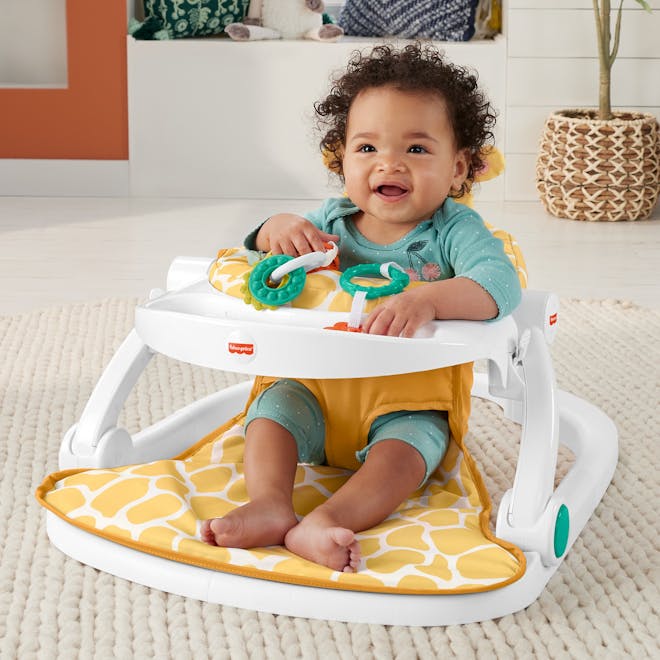Baby milestones: Sitting up
Advertisement Promotion with Fisher-Price

When your baby is around 4-7 months old, they're ready to see the world around them from a new angle … sitting up!
Your baby learning to sit up is an exciting developmental milestone. They will have been gradually building up the muscles in their head, neck and shoulders from birth. As they get stronger and are able to support their head, they'll start sitting up.
This is a big moment for your baby (and you!) and is one of the Fisher-Price Smilestones – baby milestones with a smile!
New to Smilestones? Each of your baby's milestones, from rolling over to first words, has been given an added sprinkle of fun thanks to the experts at Fisher-Price Play Lab. They’ve created toys that help babies learn important new skills, including sitting up.
FREE NEWBORN NAPPIES
Learn more about your baby’s sitting up Smilestone.
When do babies sit up?
Most babies reach this sitting Smilestone between 4-7 months old. Nearly all babies can sit up unaided by 9 months. However, bear in mind that all babies are different and develop at different rates.
If you’re concerned about your baby’s development, talk to your GP or health visitor.
What are the stages of a baby sitting up?
At 1-month-old
Your baby may be able to lift their head briefly when they're placed on their stomach. They might also be able to hold their head steady for a few seconds when you support them in an upright position.
At 2-months-old
They should be able to lift their head for a little while when lying on their stomach. They might also be able to lift their upper chest for a short while, again while lying on their tummy. This is a sign of growing strength in their head, neck and shoulder muscles.
At 3-months-old
Your baby is getting stronger! By now they should be able to hold their head steady for a few moments when you support them in a sitting position.
Your baby might also do mini push-ups with theirs arms when lying on their tummy. And, in what is a key developmental stage before being able to sit up, they might make their first attempts at rolling over!
At 4-months-old
By now your baby could well be on the move, happily rolling over by themselves. They might also start practising sitting up, by pushing forward in their bouncy chair or on your lap, or pulling themselves up on their cot bars.
The Fisher-Price® Sit-Me-Up Floor Seat with Tray gently supports your baby as they sit up and play. This helps build their core muscles ready for sitting, crawling and walking.
At 5-months-old
The opportunity to gain an exciting new perspective on the world – from a seated position – is getting closer for your baby! By now they might be able to sit up if well supported by cushions ... or even on their own. Make sure you stay nearby as they’ll still be quite wobbly and may need you to catch them if they topple sideways.
In a sign of their ever-developing muscles, your baby may also be able to push up with their arms, lift up their back, neck and head and have a good look round while lying on their tummy.
Give your baby some added support with the Fisher-Price® Grow-with-Me Tummy Time Llama. Suitable from birth, there are 4 ways to play with the llama, including as a plush toy, accessories including a mirror and rattle and a support cushion to prop your baby up during tummy time.
At 6-months-old
Your baby is likely to be able to sit up well, either supported by cushions or – for some babies – unaided. And this means they are now learning their motor skills of reaching for objects, usually with both hands, and grasping them.
Not only that, your baby might even be starting to get into a crawling position or have begun their first attempts at crawling or bottom shuffling.
At 7-months-old
By now your baby can probably sit up on their own, unsupported. As their back muscles strengthen and their balance improves, they’ll start being able to sit perfectly upright.
And now they've reached this developmental Smilestone, they could well be on their way to another, trying to pull themselves up to a standing position ready for their first steps.
At 8-months-old
Your baby will be a pro at sitting up on their own … and very much enjoying seeing the world around them!
How can I help my baby sit up?
There are lots of ways you can help your baby learn to sit up.
1. Give them a helping hand
You can help your baby learn the motion of sitting up by very gently holding their hands and pulling them up into a seating position. Then gently lower your baby down again onto their back. They’ll love the back and forth motion. However, only do this when your baby is able to support their head.
2. Give them lots of floor time
Being on the floor is a great way of helping your baby develop new skills. They’ll eventually learn to roll, sit up and crawl so encourage this by placing them on a playmat like the Fisher-Price® Kick & Play Piano Gym. Your baby can use their legs and feet to kick the giant piano keys and they can reach for toys, all strengthening their core muscles.
3. Give them lots of tummy time
This is a key way your baby can develop strength in their head, neck and shoulder muscles. They needs this strength to be able to sit up. Place your baby gently on their tummy but never leave them unsupervised. Depending on their age, your baby may be happy to be on their stomach for a few seconds or a few minutes.
The Fisher-Price® Flap & Wobble Penguin is perfect for tummy time, responding to your baby's touch with cute flapping motions and music.
Learn more about your baby’s tummy time Smilestone.

4. Encourage your baby to look up
When your baby is lying on their tummy, hold toys above them so they use their head, neck and shoulder muscles to look up. You can also stand above your baby and pull funny faces and make noises, anything to attract their attention and encourage a mini push-up.
5. Let them lean against you
Place your baby on your lap and let them lean their head and back against your chest. They’ll love the upright position!
6. Help them balance
You can do this by gently moving your baby's legs into a V-shape. This will help them balance as they sit up. However, never leave them unsupervised as they are likely to topple sideways.
What’s the next developmental Smilestone after sitting up?
Now your baby is sitting up – and able to see all the exciting things around them just waiting to be explored – there’ll be no stopping them!
Here's all you need to know about the next Fisher-Price Smilestones including walking, motor skills and early learning.
Shop the full Fisher-Price range for your baby's sitting up Smilestone (and beyond!) here.
Related content
6 surprising moments your baby is learning (without you even realising!)





